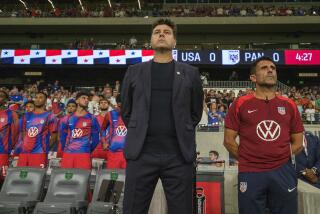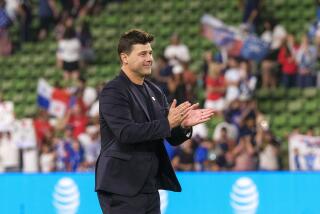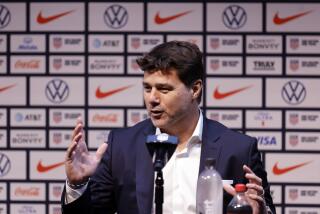U.S. Soccer Team: a Long Haul
- Share via
Two weeks ago, Tacoma Stars forward Mark Peterson, who had just joined the U.S. National soccer team for the final game of a six-match collegiate tour, was dragging himself off the field following a 1-1 tie with Penn State.
“He’s dead,” national team head Coach Alkis Panagoulias said. “I did it purposely. He can hardly breathe.”
Panagoulias realizes that to get his group ready for the second-round qualification matches for the World Cup, he has to get his players retrained from the indoor season. The U.S. team plays two qualifying-round games in the next week.
“One weakness I feel we have is the adaptation from the indoor game to the outdoor,” Panagoulias said. “It’s a very fast transition in a short period of time.”
Despite having played nine exhibition matches already this year, the players on the national team will only be together as a unit for one week before their qualifying-round game Wednesday at St. Louis against Trinidad and Tobago.
The difficulty in getting the club together has been the Major Indoor Soccer League regular season and playoffs, which still are in progress. Ten of the 17 players named last week to the national team are coming from MISL clubs, including Peterson, and some haven’t played outdoors in over a year.
“My feet were killing me,” Peterson said of his experience at Penn State. “I had blisters all over my feet from those outdoor shoes. I couldn’t get my breath.”
It’s one of the transition problems Panagoulias hopes he has minimized with a little planning.
“We gave oral directions to the players by phone for outdoor training,” he stated. “Players like Ricky Davis have been given instructions to do long-distance running to get their stamina back. I at least want to be physically fit.”
Conditioning is not Panagoulias’ only concern. Going from eight months of six-a-side, two-minute-shift soccer in a hockey rink to 45-minute halves on a 110-yard field requires reprogramming as well.
“These teams we’ll be playing are very well prepared. Our disadvantage is that we don’t have a competitive outdoor league,” Panagoulias said. “It’s not only the conditioning, but the tactical formations and plays, too.”
The team gathered for the first of its two-a-day workouts last Wednesday in St. Louis. The United States hopes this Wednesday’s game at Busch Stadium will be a replay of the 4-0 victory there last year against the Netherlands Antilles that launched the United States into the second round of qualifying.
In trying for the 1982 World Cup, the American squad was bounced in the first round despite beating Mexico for the first time in over 30 years, 2-1.
The United States last played in the World Cup in 1950, four years before the Federation Internationale de Football Association, of FIFA, instituted the qualifying procedure. Since then, the closest the Americans have come to making it into the World Cup was 1976, when it lost a one-game playoff against Canada, 3-0.
This year, the United States must get by Trinidad and Tobago, (May 15 and May 19, at El Camino College in Torrance) and Costa Rica, (May 26 in Costa Rica, and May 31 in Torrance) in its regional group to get to the third round. The Costa Ricans are 1-0-1, having beaten Trinidad, 3-0, and played Trinidad to a 1-1 tie.
In past international matches, the United States is 1-0-0 against Trinidad but 0-1-0 against Costa Rica.
It generally is agreed upon that the first match against Trinidad and Tobago will be the toughest test, due to the transition problem.
“It will be difficult,” Panagoulias said. “One advantage is that I know the players and they know me. We’ll be together for only seven or eight days before the first game, but by the time we get to the games against Costa Rica, we will have been together for the last 15 days.
“We can’t underestimate Trinidad. They have some very skillful and speedy players.”
So far in 1985, the United States has racked up a 4-1-4 record, having tied and lost to Canada 1-1 and 2-0, and also tying Switzerland 1-1. The remainder of the exhibitions were during a six-match tour against college and senior amateur teams, where the United States went 4-0-2.








